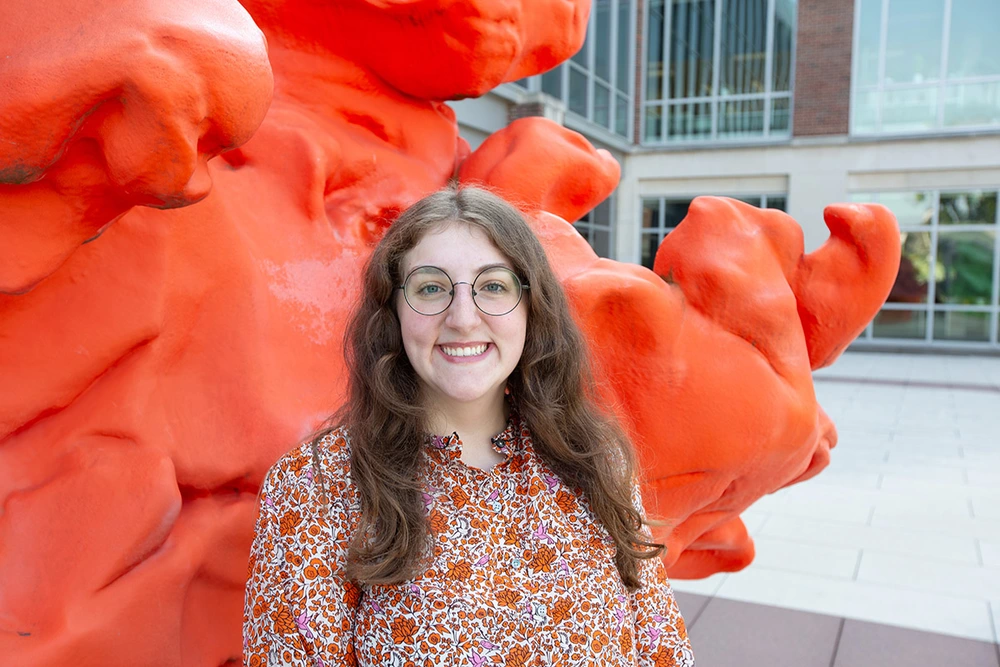
Coming into the University of Illinois Urbana-Champaign, Catherine Koterba was a pre-med student with a passion for astronomy. Three years later, she is a microbiologist studying thermophilic archaea from the hot springs of Yellowstone National Park. On the surface, this appears to be quite the career shift. Yet, for Catherine, this transition was simply the product of a deep-rooted drive to try new things and a relentless persistence to get involved with the topics that generated the most interest.
“My true, overarching passion is space,” says the senior molecular and cellular biology major, one of this year’s Carl R. Woese Undergraduate Research Scholars. “But I’ve always been interested in medicine because my mom worked as a nurse anesthesiologist. And then freshman year, I started taking biology courses and learning more about cells, and I realized ‘Oh, I’m also really interested in this.’ I considered majoring in astrophysics, but after taking a few classes it didn’t seem like the right fit. So, I ended up merging my two passions and started pursuing astrobiology.” Astrobiology is a field that explores the origins of life on Earth, life in extreme environments, and how these concepts can inform us of the potential for extraterrestrial life.
After spending her first few years testing out different research areas, including work on salamander evolution, Koterba came across the Whitaker lab in the Department of Microbiology. “I actually found the Whitaker lab because it used to be funded by the NASA Astrobiology program from 2013 to 2017,” Koterba said. “We work with thermophilic archaea, which is very applicable to astrobiology because of the extreme environments they live in.”
In Fall 2022, Koterba worked with Changyi Zhang, a senior research scientist in the Whitaker lab, imaging archaea and their viruses using transmission electron microscopy. “I love working on the microscope because I know I have the chance to see something that no one has seen before,” said Koterba.
This summer, Koterba explored the coevolutionary dynamics between the archaea Sulfolobus islandicus, found in hot springs, and one of its common viruses, Sulfolobus super-elliptical virus (SSeV). The mechanisms by which SSeV infects hosts are not well known. To better understand the infection mechanisms employed by SSeV, Koterba first infected S. islandicus with SSeV in the lab. She then verified that there was viral infection using the polymerase chain reaction method, which can isolate sections of DNA, including DNA from SSeV, and amplify them.
Making it through the long days of learning and conducting PCR were one of the major challenges Koterba faced this summer. “There were definitely days where I was struggling with PCR and was disheartened. Am I a bad scientist? But then I realized that you’re going to fail, and that’s just part of it,” she recalled. “The biggest thing I took away from this summer was, you’re going to mess up, but it’s okay. Don’t be afraid to ask for help and trust your lab mates.”
By establishing these methods for infecting host archaea, Koterba set the stage for her upcoming research this fall, when she will travel to Yellowstone to collect samples, “We’re going to be seeing Yellowstone from an angle most people don’t,” she said.
In the lab, she plans to quantify the impacts of SSeV infection on host cell growth. Furthermore, she will do DNA sequencing to identify which genetic mutations might be related to viral resistance in S. islandicus and continue to look at samples under the microscope to explore how SSeV influence host morphology. These findings will provide crucial insight into the mechanisms underlying SSeV infection and their evolutionary consequences.
When asked about the highlights of her experience in the lab, Koterba did not hesitate as she answered: “My favorite thing about the lab is the people I work with, and seeing them doing what they love. It’s pretty awesome to find people who will nerd out over the same stuff as you. Being able to work with Changyi and others in the lab has also been helpful. They are all natural mentors and have been helping with the graduate school application process.”
Outside of research and academic pursuits, Korterba is also part of the Marching Illini. She recalled visiting the University of Illinois from her hometown of Effingham, IL, for marching band competitions. “I’ve always been a band kid. We would come to the Illinois campus for band competitions and be so excited to see the Marching Illini; they were like celebrities to us.” Although they are long, strenuous days, Korterba especially enjoys performing on game day for Illinois football. “There are so many fans and alumni of the band, and it's just incredible to be part of this history,” she added. “It’s so rewarding to go out there and have people excited to see us.”
After graduating, Korterba plans on taking some time off and then apply to PhD programs in astrobiology. She is interested in studying how the extreme conditions of outer space impact cell development in mammals. Reflecting on her time at Illinois, Korterba shares a concise yet powerful motto to sum up her undergraduate experience: “Don’t be afraid to make mistakes. Don’t be afraid to take risks.”
Photo of Catherine Koterba by Julia Pollack.